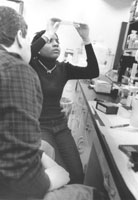|

Collaboration
Between BOE and CUNY Fosters Pockets of Excellence
By
Marylena Mantas
In
1986 the New York City Board of Education (BOE) joined forces
with the City University of New York (CUNY) to launch an innovative
program seeking to encourage and prepare minority students to
enter the medical
profession. The two partners established the Gateway Institute
for Pre-College Education,
a program created to bridge educational gaps and to lead its students
toward the path of academic success.
Today, drawing upon a 16-year-old tradition of excellence, Gateway
provides students with the tools necessary to succeed not only
in medical and science fields, but in any area they choose to
study in college. The program, which has found the formula for
success, fosters pockets of excellence in a public school system
often labeled inefficient and problematic.
“Gateway
is a program that levels the playing field for students who want
to enhance their education,” said Morton Slater, co-director of
the program. “It is a vehicle for providing education, which allows
students to decide what they want to do with their lives. We just
faciliate the choices they like to make using their education.”
Currently, over 2,000 public high school students from minority,
low income and immigrant families participate in Gateway programs
in seven public high schools—Brooklyn Tech, Erasmus Hall, Humanities,
Jamaica, John F. Kennedy, Port Richmond and Adlai Stevenson. Their
admittance to the program depends upon their academic performance
in junior high school, attendance and recommendations. Prior to
their first year in high school, students participate in a summer
program designed to bring them up to the academic level that the
program expects.
The academic life of a Gateway student differs from that of an
average student in a NYC public high school. Gateway students
have double periods of math and science; teachers who are specifically
recruited to teach in Gateway; smaller classes, tutoring sessions;
cultural enrichment activities; summer internships; and, enjoy
the benefits of strong parental involvement. A team approach and
sense of unity characterizes the program, according to Adrienne
Rubin, the coordinator of Gateway at the Humanities HS.
“We
become a family,” she said.
The success of the programs can be measured in concrete numbers:
more than 90 percent of Gateway’s entering ninth graders graduate
high school; 96 percent of the students pass the Regents biology,
chemistry and physics exam; 97 percent attend four year colleges;
80 percent complete college in four to five years; 13 percent
attend medical college—40 times the
normal rate for college graduates—and, their SAT scores are 200
points above the national average for minority students.
“Gateway
nurtures, involves, and encourages kids,” said Rubin. “It instills
pride in their
abilities and we tell them that they could realize everything
they aim for. I don’t accept
half way.”
Since 1990, approximately 2,100 Gateway students have graduated
high school; most retain close ties with the coordinators and
their high schools.
“In
my 35 years as a teacher, the last 17 have been the best,” said
Margaret Dirkin, who
has been the Coordinator of Gateway at Jamaica High School since
it was established. “To know what kids from the 90s are doing
is wonderful. It’s been a great, enriching experience. They’ve
touched my life and I hope that I have touched their life,” said
Dirkin, citing small class size and enrichment activities as,
the elements that make the program work.
According to Slater plans are underway to develop programs similar
to Gateway (funded by BOE, CUNY, NYS Step Program, and private
foundation) in other cities, including Boston.
“Gateway
is about opening options, rather than closing them,” said Slater.
CUNY and BOE: “Joined at The Hip”
Gateway is only one example of the close collaboration between
CUNY and the BOE. According to CUNY University Dean of Academic
Affairs and Deputy to the Executive Vice Chancellor, John Mogulescu,
the two institutions have greatly enhanced their collaboration
in the past two years when the two chancellors—Matthew Goldstein
and Harold Levy—realized that “in a sense they are joined at the
hip.”
College Now is only one of the programs that grew out of this
collaboration, which Mogulescu characterized as the “largest collaborative
initiative in the country.”
“We
decided that it was time to formalize the relationship with the
Board,” he said.
College Now, a program that provides high school students with
an opportunity to improve their academic abilities prior to attending
college operates in every CUNY college and provides students from
more than 100 high schools with college-oriented enrichment activities.
More specifically, College Now offers eligible high school seniors
the opportunity to take classes for college credit, which are
taught by college faculty, or high school teachers with special
training. Students who are not eligible to take these courses
can enroll in various workshops and non-credit courses. The program
also offers preparation for Regents exams and the SAT.
A second component of College Now, includes a pilot program that
was recently
instituted in 19 high schools, involving approximately 100 students
in each school, who receive among other things extra counseling
and more individualized attention. According to Mogulescu, the
program seeks to “make
a difference in how students adjust to
high school” and to “better prepare high school HS students for
college.”
In addition to College Now, the collaboration between CUNY and
BOE has led to the establishment of special projects, such as
Looking Both Ways, a development program designed to train high
school teachers to better prepare students for the English Regents.
Looking Both Ways, currently in its fourth year, has trained 300
teachers.
Summer transition programs, which bring eight graders to various
CUNY campuses for a six week, intense preparation program, have
also been established.
The collaboration has taken a more intimate form with the establishment
of seven high school on CUNY campuses.
“They
work closely with the colleges to have an enriched environment
for the kids,” said Mogulescu citing as the collaboration’s long-term
goal “to better prepare students when they come into CUNY.” Other
collaborative
programs include, Making Connections Program, College Advisement
and NYC Writing & Math Projects. #

Education Update, Inc., P.O. Box 20005, New York, NY 10001. Tel:
(212) 481-5519. Fax: (212) 481-3919. Email: ednews1@aol.com.
All material is copyrighted and may not be printed without express consent of
the publisher. © 2001.
|

